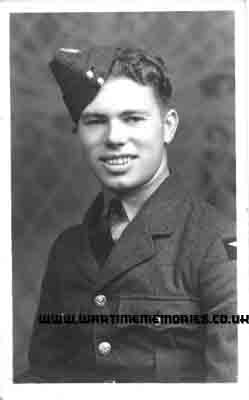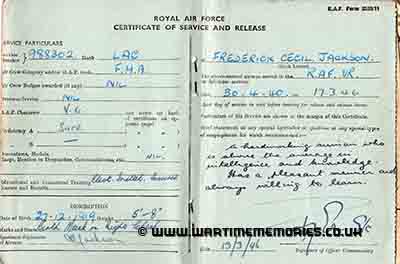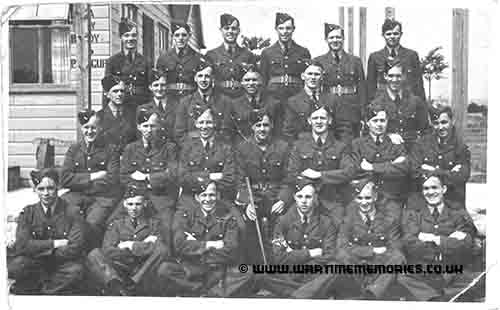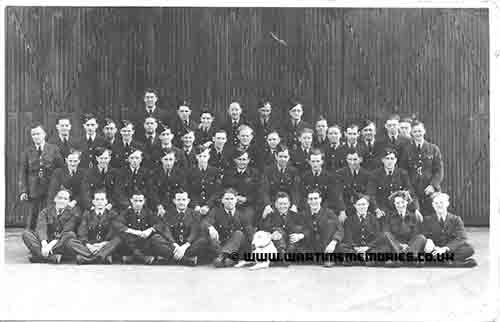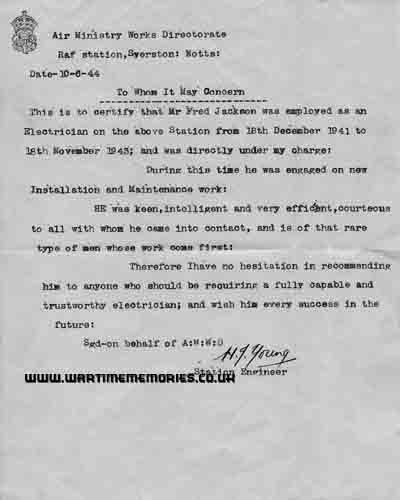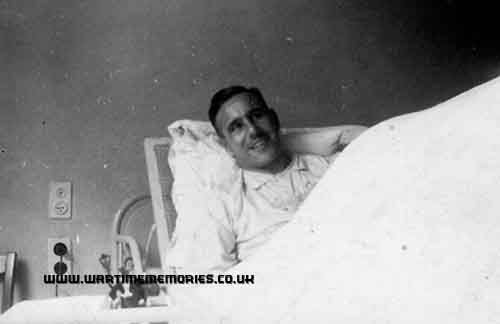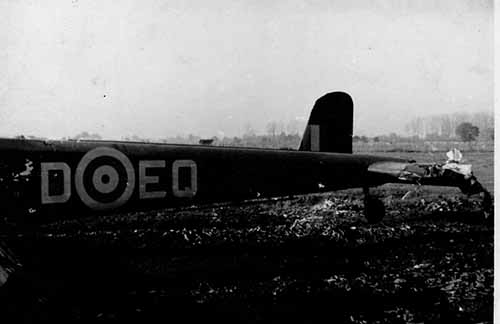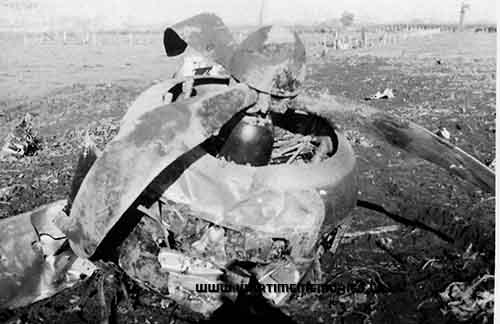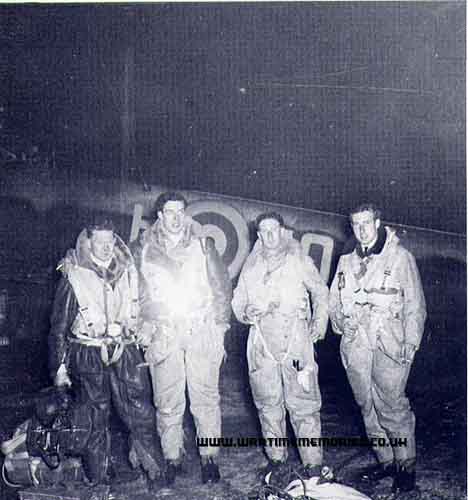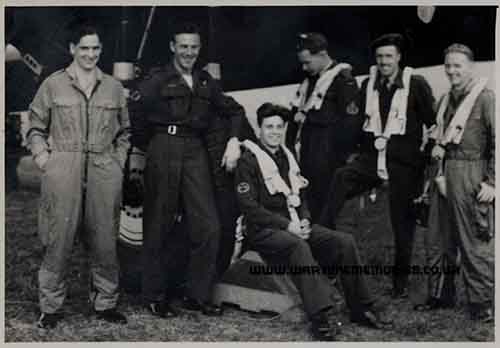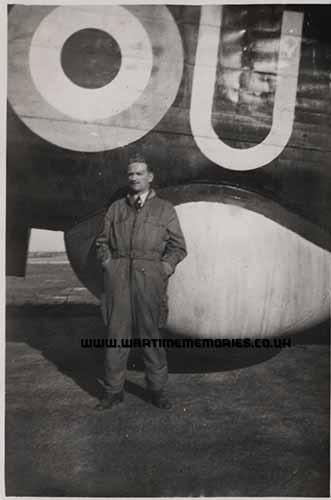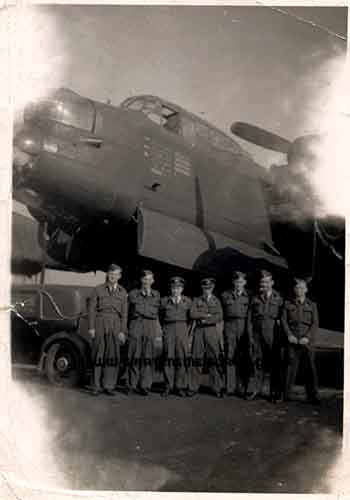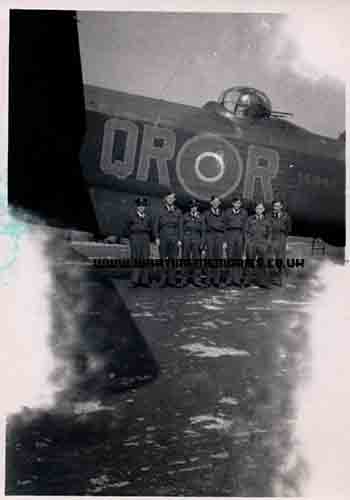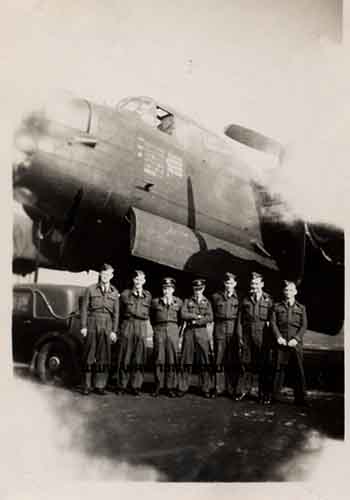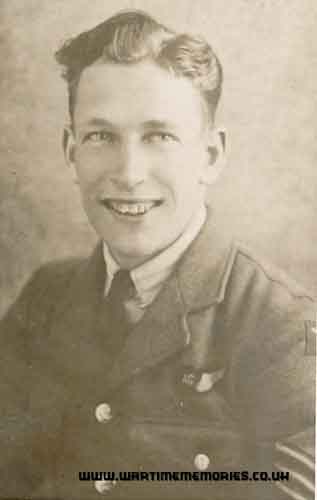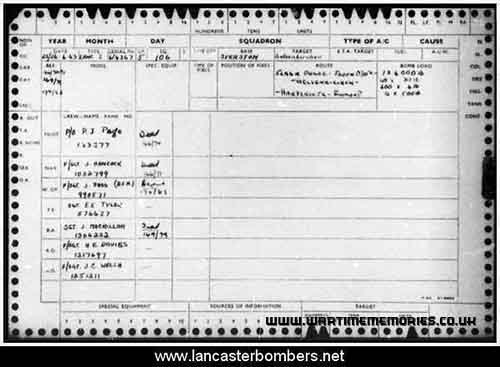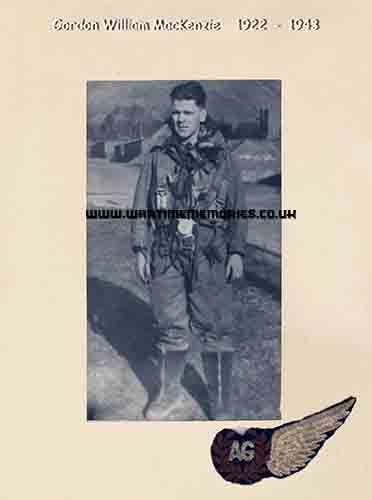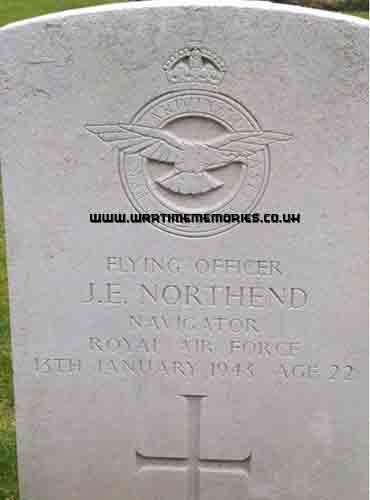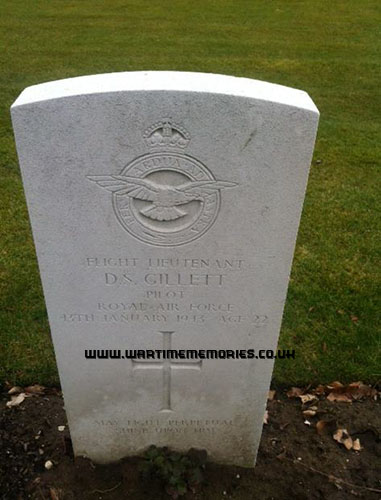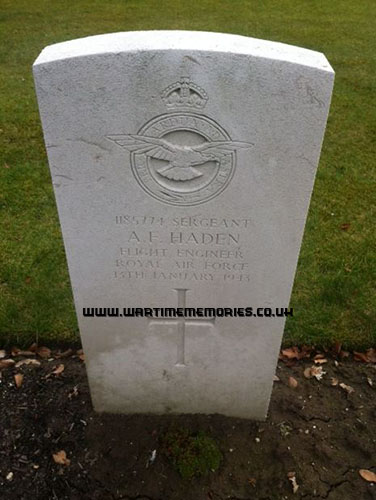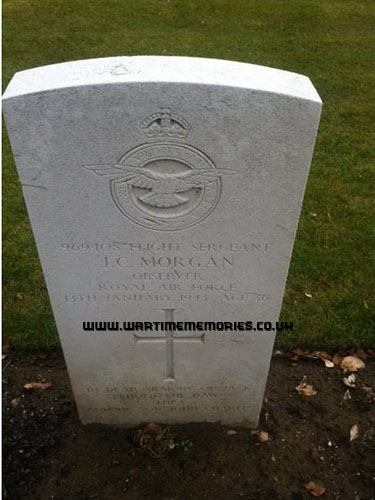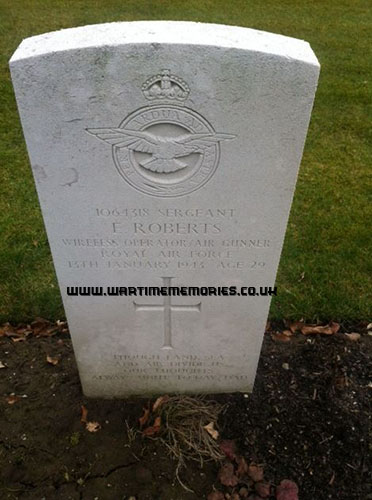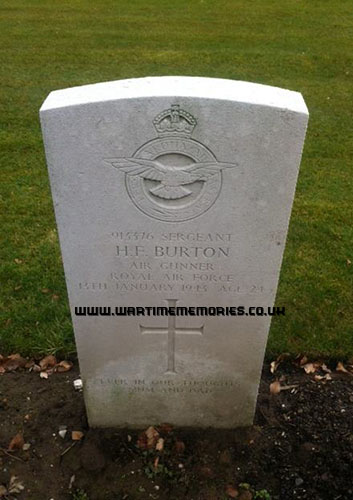|
|
|
Those known to have served at RAF Syerston during the Second World War 1939-1945. - Burton Herbert Frank. Sgt. (d.13th Jan 1943)
- Crozier DFM. David M.. P/O (d.13th Jan 1943)
- Davies Hiram Edwin. Flt.Sgt. (d.26th Jun 1943)
- Dunbar Alexander. Flt Sgt (d.13 Jan 1943)
- Edwards Frank John. Sgt. (d.13th Jan 1943)
- Elliott Newman Walter. Flt.Sgt.
- Fisher Harry. Sgt. (d.4th Sep 1943)
- Gale DFM. Norman Leslie Ernest. Flight Sargeant (d.19th July 1944)
- Gardiner Ernest Frederick. Sgt.
- Gillett David Stapylton . F/Lt. (d.13th Jan 1943)
- Haden Albert Frederick. Sgt. (d.13th Jan 1943)
- Hatt Ronald Henry William . P/O. (d.13th Jan 1943)
- Healey DFC DFM. Everard Frank Gray. Flt Lt (d.13th Jan 1943)
- Ingram John Ogilvie. Flt.Sgt. (d.10th July 1943)
- Jackson Frederick Cecil. LAC
- Joslin Peter Clement Vellacot. P/O. (d.5th September 1942)
- Jurgensen Caspar Harold. Sgt. (d.13th Jan 1943)
- Leadbitter Leonard Arthur. Sgt. (d.5th Mar 1943)
- Lloyd William B..
- Lumley Michael Hope. F/O (d.13th Jan 1943)
- MacKenzie Gordon William. Sgt. (d.3rd Aug 1943)
- Morgan John Charles. F/Sgt. (d.13th Jan 1943)
- Mullins DFM.. Alfred George. Ft Lt
- Mullins DFM.. Alfred George. Sgt.
- Norgate . Kenneth . Sgt (d.29th Aug 1942)
- Northend John Edward. F/O. (d.13th Jan 1943)
- Pennington DFC. John Ray. F/O (d.13th Jan 1943)
- Read Aubrey. (d.26th Nov 1943)
- Roberts Edward. Sgt. (d.13th Jan 1943)
- Smith Walter. Flt.Sgt.
- Ward Derek Charles. Sgt. (d.15th Oct 1942)
- Williamson Harry Rochead. Sgt. (d.13th May 1943)
- Wodehouse Frank. F/O (d.8th Aug 1943)
- Woodwart John Edward. Sgt.
- Young Alfred Markham. Sqd.Ldr. (d.26 Jun 1943)
The names on this list have been submitted by relatives, friends, neighbours and others who wish to remember them, if you have any names to add or any recollections or photos of those listed,
please
Add a Name to this List
|
|
|
The Wartime Memories Project is the original WW1 and WW2 commemoration website.
Announcements
- The Wartime Memories Project has been running for 24 years. If you would like to support us, a donation, no matter how small, would be much appreciated, annually we need to raise enough funds to pay for our web hosting and admin or this site will vanish from the web.
- 22nd April 2024 - Please note we currently have a huge backlog of submitted material, our volunteers are working through this as quickly as possible and all names, stories and photos will be added to the site. If you have already submitted a story to the site and your UID reference number is higher than 263973 your information is still in the queue, please do not resubmit, we are working through them as quickly as possible.
- Looking for help with Family History Research?
Please read our Family History FAQ's
- The free to access section of The Wartime Memories Project website is run by volunteers and funded by donations from our visitors. If the information here has been helpful or you have enjoyed reaching the stories please conside making a donation, no matter how small, would be much appreciated, annually we need to raise enough funds to pay for our web hosting or this site will vanish from the web.
If you enjoy this site
please consider making a donation.
Want to find out more about your relative's service? Want to know what life was like during the War? Our
Library contains an ever growing number diary entries, personal letters and other documents, most transcribed into plain text. |
|
We are now on Facebook. Like this page to receive our updates.
If you have a general question please post it on our Facebook page.
Wanted: Digital copies of Group photographs, Scrapbooks, Autograph books, photo albums, newspaper clippings, letters, postcards and ephemera relating to WW2. We would like to obtain digital copies of any documents or photographs relating to WW2 you may have at home. If you have any unwanted
photographs, documents or items from the First or Second World War, please do not destroy them.
The Wartime Memories Project will give them a good home and ensure that they are used for educational purposes. Please get in touch for the postal address, do not sent them to our PO Box as packages are not accepted.
World War 1 One ww1 wwII second 1939 1945 battalion
Did you know? We also have a section on The Great War. and a
Timecapsule to preserve stories from other conflicts for future generations.
|
|
Want to know more about RAF Syerston? There are:10 items tagged RAF Syerston available in our Library There are:10 items tagged RAF Syerston available in our Library 
These include information on officers, regimental histories, letters, diary entries, personal accounts and information about actions during the Second World War. |
|
Flt Sgt Alexander "Allie" Dunbar 106 Sqn (d.13 Jan 1943) My uncle Allie was a flight engineer on a Lancaster durign a raid on Essen. According to the letters I found in my mothers papers, he was caught by a night fighter on the return leg of the raid and was shot down over Appledoorn in Holland. He is buried along with the remainder of the crew, in the town cemetary in Appledoorn.
The crew were:
- F/L E.F.G.Healey DFC DFM
- Sgt A.Dunbar
- F/O J.R.Pennington DFC
- P/O D.MacL Crozier DFM RCAF
- P/O M.H.Lumley
- Sgt C.H.Jurgensen
- Sgt F.J.Edwards
|
Flight Sargeant Norman Leslie Ernest Gale DFM 57 Squadron (d.19th July 1944) My great uncle flew (and died) with 57 Sqd in WW2: Flt Sgt Norman Leslie Ernest Gale DFM, No 1297387 Flight Engineer from Sway, Hampshire. Died 19/7/44 over France - buried with 3 other members of crew in Bassevelle (East of Paris) They are the pilot, Flt Lt John Alec Bulcraig DFM, wireless operator Sgt Thomas Loughlin from Liverpool, and bomb aimer F/O Edward Chatterton Robson who was from Blackpool. The surviving crew members were, Sgt L.E.S.Manning and Sgt F.J.D.Taylor who both evaded capture and F/O E.H.Ruston who was taken POW and held in Stalag Luft 1.
I'm trying to find out circumstances of both raid my great uncle died on and his DFM
UPDATE:
The Lancaster, DX-L took off at 22:56 on the 18th of July 1944 from East Kirkby to bomb the key railway junction at Revigny. It was coned by searchlights soon after crossing the French coast and while escaping the beams wandered off course. The aircraft was shot down by a night-fighter and crashed at Bassevelle (Seine-et-Marne)
Sgt Gale had gained his award in the most hazardous circumstances while serving with No.106 Sqdn, his DFM Citation was Gazetted 28th Sep 1943. His Lancaster, JB146 had taken off at 20:10 on the 31st of Aug 1943 from Syerston and was hit by Flak over Berlin. The pilot F/O Harry Ham and w/op Sgt James Weight were wounded when the Flak struck their aircraft and both later died as a result of their injuries. The crew managed to get the aircraft home but crash-landed at 03:00 on the 1st of Sept on the Romney Marshes in Kent.
The crew were:
- F/O H.D.Ham
- Sgt N.Gale
- F/O C.Pitman
- Sgt J.E.Jones
- Sgt J.W.Weight
- F/S N.D.Higman
- Sgt T.Waller
15 years ago, Anne-Marie and Bernard Langou of Bassevelle - 77750 France have found the survivors and the families of them and the families of the people who died on 19 july 1944 when the Lancaster JB318 crashed here. We wrote a booklet (80 pages). I wrote to Ivor GALE, the uncle of Norman, many times and Leonard MANNING, the air gunner, too, but only one answer, (I have a copy for you), after no contact.
Here, at Bassevelle, we had commemorations on 1994, 1999, 2004 and 2009 with many flags, music, and english families of the crew who are now our friends (families MANNING, RUSTON, BULCRAIG, TAYLOR and ROBSON). We have made a memorial, a panel and other things.
the last ceremony : 18 july 2009.
I can give M. Padgett, what we have collected during these fifteen years and perhaps we can answer a little.
We will be honored to receive you and your familie in the village like the other families.
|
Sgt Kenneth " " Norgate 61 Squadron (d.29th Aug 1942) My late uncle Sgt Kenneth Norgate from 61 Sqd RAF is buried at the War Cemetery in Durnbach, Germany. I promised my late mother and father that I would visit the cemetery which I have plans to do very soon. I would like to find out more about my uncle, my parents always told me that he was shot down whilst flying in a Lancaster bomber over Munich during WW2. I would like to find out where 61 sqd was based and details on my uncles last bombing mission.
UPDATE: Lancaster R5742 took off from RAF Syerston at 2105 on the 28th of August 1942 on a mission to Nuremburg. All the crew were lost on this mission and are buried in Durnbach War Cemetery.
The crew were: -
Sgt K. Norgate
- F/S. J. E. Richards
- P/O W. S. Pattinson RCAF
- F/S F. Janiszewski RCAF
- Sgt L. M. Cowan RCAF
- Sgt W. Toole
- P/O J. A. Wright RCAF
F/S Richards was an American from San Francisco serving in the RAF. His brother, Branson Richards, also died on Active Service.
|
Ft Lt Alfred George "Fred" Mullins DFM. 61 Squadron My father, Flight Lt Alfred George Mullins DFM, was doing his tour of duty in 61 Squadron during 1943 as a sergent flight engineer on Lancaster bombers. After one of the bombing raids over Germany their aircraft was damaged by flak and the hydralics were badly damaged, on returning to Syerston in order to get the undercarriage down to land my father filled the hydralic accumilator with all liquid available on the aircraft which enabled them to lower the under carriage and land. However, he got it in the neck from the ground crew at dispersal because they had to work all night to repair and flush the system through ready for the next operation. On another occasion the same aircraft QR-Q, on landing and near the end of the runway the undercarriage collapsed and the aircraft slid into a field at the end of the runway where potato pickers were running for their lives. All the crew laughed afterwards because some of the potato pickers were throwing potatos at the aircraft in retaliation for being frightened, no one was hurt. The aircraft was sent to an MU for repair. These stories my father told me when I was young
|
Sgt. Alfred George Mullins DFM. 61 Sqd. In 1943, P.O.Parsons the pilot, and my father, Sgt A.G.Mullins the flight engineer were landing at RAF Syerston in Lancaster QR-L, they touched down and half way down the runway the undercarriage collapsed. Everyone hung on for dear life as the Lanc careered onward off the runway and through the fences into a potato field where it came to a halt. The engineer's foot rest bar, which was quite thick was bent. The field was full of potato pickers who were quite upset and started throwing some of their potato's at the stricken aircraft. After hours of flying over enemy lands, slight flack damage, but successful return they get potato's thrown at them! This story was told to me when I was young by my father Flt Lt A.G.Mullins DFM.
|
F/O Frank Wodehouse 106 Sqd. (d.8th Aug 1943) I am researching a family relative F/O Frank Wodehouse of 106 Squadron who died on 8th Aug 1943 after a raid on Turin. I would like to find out his Service history, his Flight Log and his Medal awards. - I have medals but ribbons are worn and we think there was a bar to one on them.
Lancaster BIII DV 196 -ZNK Syerston of 106 Squadron (County of Nottingham) flying from Syerston departed at 20:55 on 7th Augusts 1943 for a bombing mission to Turin in Italy. During the return leg of the mission the Lancaster was intercepted by the radar station of St Jean Dackel Beef and was shot down. The victory being awarded to Captain Hans Wolfgang von Niebelschutz, Staffelkapitan of 5 ° Staffel II / NJG 4 (Dijon-Longvic) ME110 Night Fighter.
Inside the Lancaster some unused incendiary projectiles ignited, and the evacuation order was given. The aircraft crashed at 2:55 in the morning near Vandenesse en Auxois and broke in two during the crash, 2 engines fell into a field, the other 2 in a stream. The pilot and bombardier were unable to evacuate the aircraft, lost their lives and were buried at Vandenesse en Auxois
The crew were:
- Flying Officer Frank George Wodehouse, aged 20 (pilot)
- Sgt. John Cole, RAFVR aged 21 (bombardier)
- Sgt AR Kidley (upper gunner)
- Sgt JW Windiate RCAF (observer)
- Sgt HL Nielsen 1077104 (wireless op)
- Sgt T Adams 908221 (engineer)
- F/O Gourlick RCAF J13457 (rear gunner)
|
Sgt. Harry Fisher 106 Squadron (d.4th Sep 1943) Harry Fisher was my Mum's brother. Very little was ever said about him as my Nana was too devastated to talk about him. I am very keen to learn more about him. I have found out that he is buried in Hanover and am planning to visit his grave. Does anyone have any information on him. He died on the 4th of September 1943 how can I find out which sortie was he on?
Editors Note: Bomber Command Losses records that Lancaster ED385 took off at 19.30 on the 3rd of September 1943 from Syerston. It crashed into a thickly wooded area between Burgdorf, 20 km from Hannover and the town of Uetze. All the crew perished and are buried in Hannover War cemetery.
The crew were: - F/O L.W.Roper RAAF
- Sgt K.E.Bright
- Sgt A.s.Carscadden
- Sgt K.D.Wellwood RCAF
- Sgt H.Fisher
- Sgt E.A.Cannon RCAF
- Sgt R.C.Woolnough
|
Sgt. Leonard Arthur "Arthur" Leadbitter 106 Sqdn (d.5th Mar 1943) Leonard Arthur Leadbitter, enlisted in the R.A.F in October 1938 he trained as a ground staff radio operator. When war came, one after another of his comrades did not return from operational flights he decided to avenge their deaths and applied to transfer to air crews and trained as an air gunner. Until march 1943 when he was reported missing his mother, my great grandmother Mary Leadbitter, thought he was still working on the ground staff. Leonard thought his mother would worry if he told her he was flying. So after long raids he would return home and tell her he was in a safe spot on radio staff. His only worry was his mother would find out he was flying. His mother received a consolation letter from Wing Commander Guy Gibson who awarded his brillant leadship and said he was a very fine rear gunner. Leonard was killed on the 5th of March 1913, his Lancaster took off from
Syerston at 18.57 on a mission to Target Essen. They were shot down at 21.15 in target area. Leonard is buried in the Reichswald Forest War Cemetery.
I'm so proud of my great Uncle and am so pleased that there is going to be a memorial for these brave brave men. God Bless. x
|
Flt.Sgt. Walter Smith 106 Sdq. My Father, Walter Smith, originally signed up in 1941 and was sent to the Isle of Islay to train as an electrician. Whilst he enjoyed the summer, he was not keen to stay the winter in such a cold climate, so decided to volunteer for flying training instead. He did his air crew training in Bridlington in 1942 and qualified in early April 1943 as an air gunner. Originally based at Syerston, he then moved base to Metheringham.
He flew on 30 operations between August 1943 and April 1944. On his 30th and last operation on 27th April 1944, his report book confirms that, on the way back from Schweinfort, his Lancaster was intercepted by a night fighter whose fire set light to a fuel tank. One of the crew, Sgt. Jackson, got out onto the wing to try and put out the fire. He was later awarded the V.C. for his bravery. The remainder of the crew abandonded the plane, with all but two surviving. The captain of the plane 'Miff' Mifflin of course remained until last and was one of the two who did not survive, along with Flt. Sgt. Johnson. My Father insists that 'Miff' was the bravest amongst them all. My Father gave himself in to the Germans three days later and spent the rest of the war as a POW. I am a very proud daughter.
|
William B. Lloyd 106 Squadron My grandfather, William B Lloyd, served as both a Rear and Mid-Upper Tail Gunner in World War II. He was trained at No. 3 B & G school in Macdonald' Manitoba. Then embarked from Halifax to go overseas in October of 1943. He was staying in Bournemouth for a few months and was in and out of the hospital due to severe bronchitis.
From his logbook it states that he was at No. 17 O.T.U Turweston from December 14 1943 - February 20 1944 and was in the hospital again for the rest of Feb and March of '44. In April - May 1944, he was stationed at No. 1661 Heavy Conversion Unit in Winthorpe and then at the end of May and June 1944 at RAF Syerston where he started with the following crew:
- Pilot Jack Netherwood
- Navigator H S Wyatt
- Bomb Aimer Glen Hendry
- Wireless A.G L.J Lucas
- Mid Upper A.G A.R Parisani
- Rear A.G - W.B Lloyd
From June of 1944 through to February of 1945 he was stationed at RAF Metheringham in Squadron 106. He completed 13 Ops with his original crew and then became grounded from flying due to bursting his ear drums and severe colds while the rest of his crew finished their tour. Once cleared to fly again he completed 6 Ops as a "Spare Bod" gunner flying with any crew that needed him. The next 11 Ops he completed with an Australian crew and Skipper by the name of Gord Laidlaw.
In March of 1945 he and the Australian crew were stationed at RAF Coningsby as part of the Pathfinder Force, Squadron 83. They completed 3 Ops there. In total my grandfather completed 18 OPS as a rear gunner, and 15 as a Mid Upper. A total of 33 trips.
I was fortunate enough to conduct an interview with him about his time in the war a few years before he passed away. As well he kept his flying logbook in great condition and his mother kept all the letters he wrote home to her as well. With these documents I have spliced together his war time experience. I am honoured to have a grandfather who was proud to fight for his country and freedom and survive as well. I hope my contributions to this website are insightful in some way.
|
LAC Frederick Cecil Jackson My father, Frederick Cecil Jackson was an LAC and his trade trade FMA.
As usual the relevant questions were not asked at the time and now it is too late. My father very rarely spoke of his time in the R.A.F just a casual comment. I know he served at Syerston in June 1944 as I have a recommendation and a photo of a dispersal point at Cardington dated 18th March 1946. Any information would be much appreciated.
|
Sgt. John Edward Woodwart 408 Sq Hampden 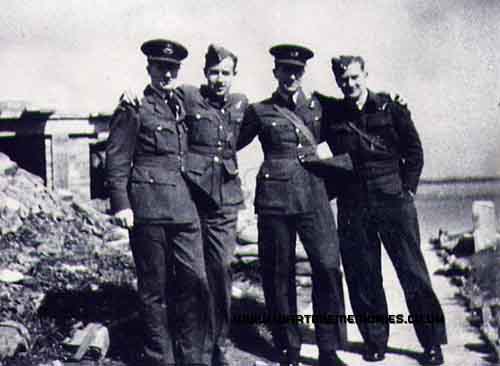     The Hampden document
In October 2006 I found some photos again I received from my father of a plane crash in October 1941 in the vicinity of Venlo (The Netherlands). I recognized a Hampden and on the tail I could read the registration EQ-D.
I have some pictures of the plane but also a picture of a man lying in a hospital bed and at the backside of this picture my father had written that it was captain Thompson, one of the crewmembers of the Hampden.
With the aid of the internet I found out that the plane belonged to the 408 RCAF Sq and on a veteran site I contacted the webmaster to ask if he knew anything about a Hampden with the EQ-D registration and a crewmember named Thompson. I received an answer about the Hampden EQ-D that crashed in Limburg (province of The Netherlands and Venlo lies in that area) on 8/9 November 1941, but the crewmembers were:
P/O E.L. (Bill) Houghton (RNZAF)
P/O J.C. Monkhouse (RCAF)
Sgt A.J. (Jack) Gallan
Sgt J.E. (John Edward) (Jack) Woodwart
This had to be the Hampden I was looking for, so I asked the webmaster if he would put a question on the site to see if there were any relatives or crewmembers who were interested in my photos. A few days later I got an email from a guy in The Netherlands who was interested in WW2 crashes and he told me that a book existed about the former German Airfield near Venlo and in this book I could read more about the plane. He also gave me a name and address of a person who had the same passion and knew everything about WW2 crashes in Limburg. I obtained the book and there I read:
The Hampden with 4 other planes took off in the evening the 8 of November 1941 at 17.19 local time from Syerston for a bomber attack on the Krupp steel factories at Essen (Germany). They set course to checkpoint Skegness and then to the isle of Texel (The Netherlands) Then they set course to the target, dropped their bombs and made a course at 270 degrees back home. At 22.30 they reached the airspace of Venlo and were engaged by a ME 110 nightfighter flown by Willi Dimter of Nightfighter Sq 1 Venlo. It appeared that both engines of the Hampden were hit and Bill Houghton made a perfect belly emergency landing (a masterpiece in the darkness) in the neighbourhood of Renkensfort at Maasbree (about 10 km away from Venlo)
At the landing 3 crew members were unharmed but one was injured (broken leg) and because of that it was impossible to transport the wounded and therefore the rest of the crew decided to stay together, waiting for the arrival of the Germans. However before the arrival of the Germans one of the crewmembers handed over the documents they had to one of the earlier arrived locals.
Willi Dimter crashed on September 17th 1942.
Two weeks later I visited Mr 't Zandt in Venlo and he gave me copies of the photos he had. A picture of the original crew (instead of Sgt Woodward, P/O Bill Bishop belonged to the original crew), another picture of the plane and copies of the documents that were handed over to one of the locals at the crash site. About a month later I got an email from Judy Greers from New Zealand who was a daughter of Jack Woodwart and she told me that her father died in 1990 but had not talked much about the war. She knew that he had been a POW for 3 years after a plane crash in The Netherlands in 1941. On that plane he was a replacement in that crew.
During a evacuation of the camp, Woodwart managed to escape and at the end of the war he got back by boat to the UK where he later graduated as a optician in Manchester. There he met his wife and in 1956 the family emigrated to New Zealand, first to Christcurch and then to Timaru.
I mailed the whole story and photos to Judy Greer and she told her mother about it and 2 weeks later she mailed back with another interesting story:
“My mother relates an interesting event that happened in the 1970's - my father was working as an optician in Timaru and had agreed to do some optical work in Greymouth on the West Coast. He flew over and that evening was sitting at dinner with the other people in the hotel including the flight crew. He heard a page over the hotel intercom for a "Mr Houghton" and when he saw this man was one of the group he was sitting with, he asked if he knew or was related to the Houghton (in the crash). Amazingly this man was the same Houghton - who was a New Zealander. Also amazing was that this flight to the West Coast was the first flight my father had been on since the crash in 1941 and the pilot was the same Houghton!!!”
About a year later I bought a book about the Hampden bomber and in the book again I was confronted with a picture of the EQ-D with its crewmembers. So now I’m eager to hear more about a perhaps continuing story?
|
Sgt. Harry Rochead Williamson 83 Sqn. Wyton (d.13th May 1943) The War Memorial in the grounds of my old school in Edinburgh carries the names of about 200 former pupils who gave their lives in the Second World War, 84 of whom served in the RAF. About 50 of those flew with Bomber Command, including my late Uncle Harry. (Sgt. H R Williamson, RAFVR – Service No. 1365974).
Harry Williamson left school in July 1939 having decided to take up farming and he started work as a ‘mud student’ on a farm at the upper end of the Lauderdale valley, Berwickshire. Thereafter he intended to enter the College of Agriculture in Edinburgh.
Harry’s elder brother, Walter, had joined the RNVR before the war but on the outbreak of hostilities he was quickly called up. Although agriculture was a reserved occupation, Harry decided to join the RAFVR and signed up on 28 October 1940. I have been unable to establish his reason to join up and can only speculate that this was due to either peer pressure or indeed family pressure, although the latter was unlikely.
He was selected for Pilot/Observer training and returned to work on the farm for a further 6 months until he received his call-up papers at the end of March 1941. During his initial training, Harry met several FP friends he had not seen since leaving school. Early in July he set sail for Halifax, Nova Scotia, followed by a long train journey to Arcadia in Florida for pilot training which, much to his disappointment, he failed. Returning to Canada, he was stationed at various RCAF and RAF airfields, receiving training in radio, navigation and general skills.
Christmas 1941 was spent at sea returning to Britain. After much ‘downtime’ at Bournemouth and Hastings, he was posted up to ACRC in London and, at the beginning of April, he was posted to RAF Ansty near Coventry to try again (rather unusually) for his pilot’s wings. Alas, he failed again and off he went to ACDW at Brighton before travelling north to West Freugh, Stranraer and then to No. 10 (O)AFU at Dumfries for air gunner and observer training.
The trail so far has been obtained partly from his frequent letters home to his mother and those I now hold on behalf of the next generation. There was never any reference to any military matters whatsoever but Harry always commented on what was happening in the farming scene surrounding him and how some of the husbandry practices differed from those he had seen in the Scottish Borders. He greatly missed the farming life which had been interrupted by the war.
After obtaining a copy of Harry’s Service Records from RAF Cranwell, I then had the ‘master key’ to requesting further information from the Air Historical Branch at RAF Northolt. They provided me with helpful answers to a list of questions as much of the information in his ROS was abbreviated in a format which only those in the know could interpret!
Unfortunately my uncle’s Flying Log Book was missing so the next contact was The National Archive (TNA) at Kew, London. Knowing his two operational squadrons, 106 Sqn. RAF Syerston (2 February – 30 March 1943) and 83 Sqn. RAF Wyton (end of March to mid-May 1943) narrowed down the search. The Squadron Operational Records from TNA produced very interesting information, including details of his 14 missions with 106 Squadron and 10 missions with 83 Squadron, crew, aircraft type, targets, bomb loads and target indicators carried, the latter when flying with 83 Sqn. as Pathfinder Force. Harry had retrained as a Bomb Aimer before being posted to Syerston so he would be interested in what his Lancaster’s bomb bay held and particularly the 1,000 lb bomb hang-up on the return from a raid on Stettin. When he was stationed at Syerston, Harry’s missions included Cologne, Hamburg, Lorient, Bremen, Nuremberg, Cologne, St. Nazaire, Berlin, Hamburg, Essen, Nuremberg, Baltic Sea (mine-laying), Essen and St. Nazaire.
When Harry and his crew transferred to RAF Wyton, the wireless operator, Sgt. T. Whiteley, did not remain with the all-sergeant crew but no explanation for this was available. Information found recently on the internet confirmed that Whiteley was killed serving with 44 Sqn. on a raid on Hanover in mid-January 1944. The replacement W.Op./AG was F/O S. W. Gould.
Harry’s targets with 83 Sqn. were Berlin, St. Nazaire, Essen, Kiel, Duisburg, Pilsen, (he flew as ‘odd bod’ on this mission with another crew), Spezia (Italy), Stettin, Duisburg, Dortmund (return flight with two engines u/s and the third overheating) and Pilsen – this fateful final flight being cut short over the Netherlands on the night of 13/14 May 1943. F/O Gould was the sole survivor of the crash near Lemmer in Friesland and was a POW in Stalag Luft III, Sagan until May 1945. Attempts to locate him or his relatives have not been successful to date and attempts to trace relatives of Sgt. A.S. Renshaw brought our enquiries fairly close but then faded possibly when family sensitivities were introduced. Relatives of the remainder of the crew have been located by me and a Dutch friend over the past 12 years or so.
Harry certainly packed in a lot of operational flying in three and a half months but he would be required to complete a total of forty missions on his first Tour as part of a PFF Squadron.
One important piece of advice I offer to any reader considering a similar search of a relative’s service in Bomber Command is to start now – do not put off to a future date! Although much information is held in TNA, that wartime generation who knew the Bomber Boys is getting a bit thin on the ground and getting first-hand answers to questions is not easy. If only I had started asking the questions about 10 years ago then both Harry’s sisters would have still been alive and fit enough to provide some more information.
The crew of Lancaster W4981 killed in the crash are buried in the village cemetery in Lemmer. I have visited my uncle’s grave several times over the years and I plan to return this September (2010). A meeting is arranged to meet for the first time with my Dutch friend who knows the crash site and who also has several artefacts from the aircraft.
My uncle’s aircraft was shot down by a Messerschmitt 110 night fighter piloted by Oberleutnant Lothar Linke, a German ace with 28 RAF aircraft to his credit. He in turn was shot down a few days later and did not survive the crash. The 110 was a notoriously difficult aircraft to bale out from with crew frequently hitting the tailplane.
Although my Dutch contact sent me copies of archive newspaper articles of this crash, material is also available on the internet. What a source of information if you know how to work through the system!
Somewhere out there I feel there is still information available to complete my search for
relatives of the two afore-mentioned aircrew. The following names of the complete crew may jog a few memories:
- Sgt. A. S. Renshaw (535117) – Pilot
-
Sgt. H.R. Williamson (1365974) – Bomb aimer
-
Sgt. J.E. Lecomber (1393387) – Navigator
-
F/O S.W. Gould (47704) – W/Op.
-
Sgt. F.A. Worsnop (1083323) - F/Engineer
-
Sgt. J.M. Hargreaves (1310051) – M/U/G
-
Sgt. J.R. Stone (1323951) – R/G
Harry had a long journey from his Aircrew Candidate Selection Board interview on 28 October 1940 in Edinburgh which finished near Lemmer in The Netherlands on 13 May 1943, dying at the age of 22 years.
‘Dying for a noble cause is not the worst thing,
Being forgotten is’
|
Flt.Sgt. Newman Walter "Bill" Elliott 61 Squadron My Father Newman "Bill" Elliott was a Rear Gunner, he trained at No.5 Lancaster Finishing School at Syerston, Nottinghamshire from
July 29th to August 8th 1944. He then joined No. 61 Squadron at Skellingthorpe, Lincolnshire. His missions were all flown with F/O Cooksey.On August 10th - 29th 1944 his Logbook shows Lancasters flown in:
MF 912, BJ183, EE17, PD266, ED8s60, PB434 R
, Between September 10th - 27th 1944. PB434 R, Non specific 729 V, H, G, D.
From October 1st to November 29th 1944. All operations LL843 R.
From December 1st to 17th 1944. LL843 R, Non specific L.
From January 12th - 27th 1945. All LL843 R
From February 1st to 21st 1945. LL843 R, Non specific Q.
March 1st to 11th 1945. LL843 R, Non specific O & Y.
His tour expired 11th March 1945 when he had flown Thirty Six ops. I am researching further.
|
Flt.Sgt. Hiram Edwin Davies 106 Sqn. (d.26th Jun 1943) On the 25th of June 1943 at 22:45 Lancaster I W4367 ZN of 106 Squadron
took off from RAF Syerston, Flintham, near Newark, Nottinghamshire, the
target was Gelsenkirchen (Nordstern). The aircraft crashed off the coast of Holland and all crew killed 2 bodies not recovered or identified
The crew were:
- Davies H E Flight Sergeant Air Gunner aged 22 had left his dog tags behind, remembered on the Runnymede Memorial.
-
Hancock J Flight Sergeant Navigator aged 31 buried in Harderwijk General Cemetery
- Macmillan J Warrant Officer Bomb Aimer aged 32 buried in Amsterdam New Eastern Cemetery
- Page P J Pilot Officer Pilot aged 22 buried in Harderwijk General Cemetery
- Pass J Flight Sergeant W.Operator/Air Gunner aged 27 buried in Harderwijk General Cemetery
- Tyler E E Sergeant Flight Engineer aged 19 buried in Harderwijk General Cemetery KIA
- Welch J C Flight Sergeant Air Gunner aged 22 remembered on the Runnymede Memorial.
|
Aubrey Read 106 Sqdn (d.26th Nov 1943) My uncle Aubrey Read was a WOP/AG with 106 Squadron. His regular Lancaster was ED593 ZN-Y - which was previously Guy Gibson's 'Admiral Prune II'.
On 26/11/43 my uncle's crew volunteered for a raid on Berlin using JB592 (ZN-W) and failed to return. I believe this was 106 squadron's first day of operations from Metheringham following their move from Syerston. Sad to say my uncle never returned.
|
Sqd.Ldr. Alfred Markham Young 106 Squadron (d.26 Jun 1943) 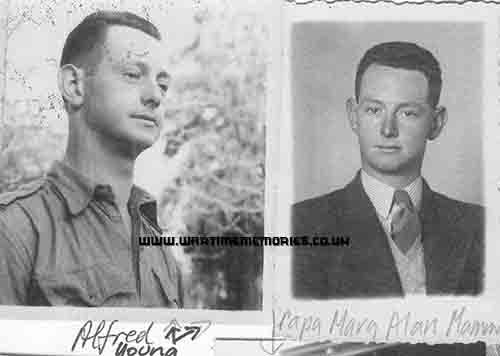 Alfred Markham Young was born on 9th of June 1917 in Marrickville, New South Wales, the third child of Alfred Gordon Young and his wife, Vera Blanche Markham. His father was a successful barrister in Sydney, Australia.
Alfred Markham travelled to England in 1939 and joined the Royal Air Force where he trained as a pilot, one of twenty thousand Australian airmen who served with Bomber Command during the 1939-45 War. Alfred was a Squadron Leader in 106 Squadron Bomber Command, Service No. 36135, and was stationed at RAF Syerston near Newark, Nottinghamshire.
Alfred was killed during the Battle of the Ruhr on 26 Jun 1943. Flying a Lancaster Mark III, Serial No. ED125, Code ZN - Alfred's final mission departed at 22.40pm on 24 June 1943 when 473 RAF bombers attacked the Nordstern synthetic-oil plant at Gelsenkirchen. The raid was unsuccessful due to cloud and "unserviceable" equipment on 5 of the 12 Oboe-equipped Mosquitoes.
Alfred's plane failed to return and it is not known where it crashed. He was 26 years of age and is remembered on the Runnymede Memorial, in Surrey, England.
|
Sgt. Gordon William MacKenzie 61 Squadron (d.3rd Aug 1943) Gordon MacKenzie was transferred from No.1661 Conversion Unit to 61 Squadron at RAF Syerston on 20th of July 1943. His aircraft failed to return from a raid on Hamburg on 2nd/3rd August 1943, just two weeks after arriving on base. He was my cousin.
|
Sgt. Derek Charles Ward 106 Squadron (d.15th Oct 1942) 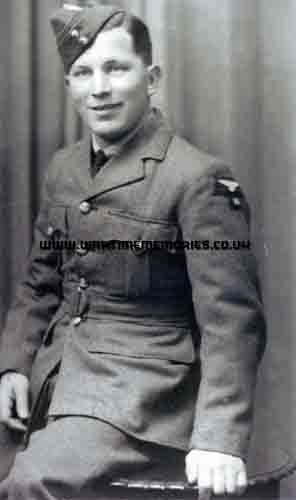 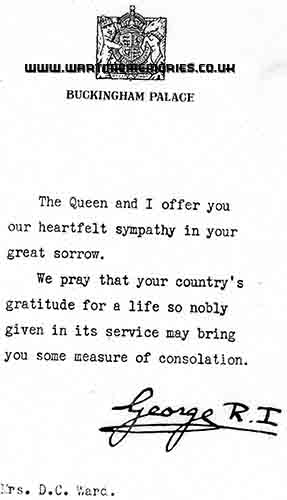 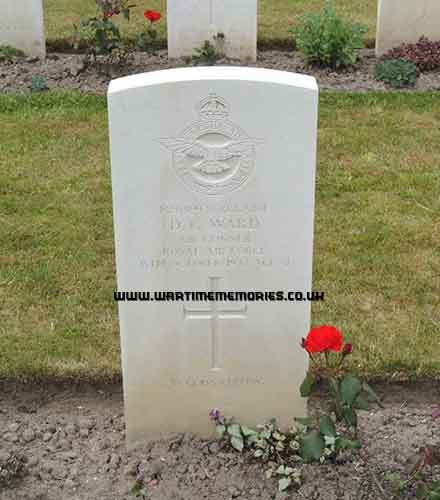 Derek Ward was my grandfather. I have only very recently been able to obtain any information about him at all. The very little I know is that his last flight was upon Lancaster W4771
Lancaster W4771 took off from Syerston at 19:25 hrs to attack targets in Cologne which was completed successfully. Shortly after leaving the target area, and while flying at 17,000ft in the Cologne - Monchengladbach area, the Lancaster was hit by flak. It is thought that two members of the crew were killed by the flak burst and the pilot was killed when the aircraft crashed.
Crew:
- P/O T.B. Crowfoot. DFC. RAFVR. Pilot. 129665. Age 30. He was married to Gladys Dorothy Crowfoot and lived in Thetford, Norfolk. He is buried in the Rheinberg War Cemetery, grave 2.B.19.
- Sgt E.J.C. High. RAFVR. Survived. Prisoner of War. He was taken to Stalag Luft Heydekrug and given the POW No.824. During captivity he was promoted to Warrant Officer.
- F/O A.S. Meara. RAFVR. Survived. Prisoner of War. He was taken to Stalag Luft Sagan and given the POW No. 771. He was subsequently promoted to Flight Lieutenant
- F/O A/L. Dickinson. RAFVR. Survived. Prisoner of War. Taken to Dalag Luft Sagan and given the POW No. 42818. Later promoted to Flight Lieutenant.
- F/O P.D. Smale. RAFVR. Wireless Operator. 109045. Age 20. He came from Newton Abbott, Devon. He is buried in the Rheinberg War Cemetery, grave 2.B.20.
- Sgt R.E. Christy. RAFVR. Survived. Prisoner of War. Taken to Stalag Luft Kopernikus and given the POW No. 809. He was later promoted to Warrant Officer.
- Sgt D.C. Ward. RAFVR. Rear Gunner. 1386499. Age 31. Son of Walter and Elizabeth Mary Ward and married to Sylvia Ward of Upwell near Wisbech, Cambs. He is buried in the Rheinberg War Cemetery, grave 2.B.21.
The actual site where the Lancaster crashed is unknown.
|
F/O. John Edward Northend 61 Squadron (d.13th Jan 1943) John Northend was a navigator on Lancaster B1 W4192 QR-E, which took off from RAF Syerston at 03:35 on 13th January 1943 as part of a 55 Lancaster raid on Essen, target indication being provided by four Mosquito aircraft from the Pathfinder Force. The aircraft crashed at Mettman, 14 km East North East of Duesseldorf Germany, all the crew were killed. Initially, they were buried at Nordfriedhof, but were reinterred in the Reichswald War Cemetery after the War.
|
P/O. Peter Clement Vellacot Joslin 61 Squadron (d.5th September 1942) Pilot Officer (Pilot) Peter Joslin was the son of John Henry and Mary Ruth Joslin, husband of Mildred Helen Joslin of Black Notley, Essex.
He was aged 30 when he lost his life and is buried in the Idaarderadeel (Wartena) General Cemetery, Friesland, Netherlands.
|
Flt.Sgt. John Ogilvie Ingram 61 Squadron (d.10th July 1943) Flight Sergeant (Pilot) John Ingram was the son of James and Catherine Ingram of Cambo, Northumberland. He is buried in the Losser General Cemetery, Overijssle, Netherlands.
|
F/Lt. David Stapylton Gillett 61 Squadron (d.13th Jan 1943) Early in the morning of 13th of January 1943 Lancaster bombers of No.61 Squadron, No.5 Group Royal Air Force were part of a force of 55 Lancasters from Nos. 1 & 5 Groups with target indication by 4 Mosquito aircraft from the Pathfinder Force, taking part in an attack on the Krupps works at Essen, one of the cities in the industrial heartland of Germany, the Ruhr. The Oboe equipment of the first Mosquito to arrive failed and the other 3 Mosquitos were all late. Because of this many of the Lancasters bombed on dead reckoning.
The pilot of one of those aircraft was Flt Lt David Gillett, and his Lancaster MkI W4192 QR-E took off at 03:35hrs from RAF Syerston. It crashed at Mettman, 14 km ENE of Dusseldorf, where the crew, who were all killed, were buried in the Nordfriedhof on 18th of January 1943. Their graves are now in the Reichswald War Cemetery.
|
Sgt. Albert Frederick Haden 61 Squadron (d.13th Jan 1943) Early in the morning of 13 January 1943 Lancaster bombers of No.61 Squadron, No.5 Group Royal Air Force were part of a force of 55 Lancasters from Nos. 1 & 5 Groups with target indication by 4 Mosquito aircraft from the Pathfinder Force, taking part in an attack on the Krupps works at Essen, one of the cities in the industrial heartland of Germany, the Ruhr. The Oboe equipment of the first Mosquito to arrive failed and the other 3 Mosquitos were all late. Because of this many of the Lancasters bombed on dead reckoning.Flight Engineer Albert Haden is buried in the Reichswald War Cemetery.
|
F/Sgt. John Charles Morgan 61 Squadron (d.13th Jan 1943) Early in the morning of 13th of January 1943 Lancaster bombers of No.61 Squadron, No.5 Group Royal Air Force were part of a force of 55 Lancasters from Nos. 1 & 5 Groups with target indication by 4 Mosquito aircraft from the Pathfinder Force, taking part in an attack on the Krupps works at Essen, one of the cities in the industrial heartland of Germany, the Ruhr. John Morgan was the bomb aimer on Lancaster MkI W4192 QR-E, which took off at 03:35hrs from RAF Syerston. It crashed at Mettman, 14 km ENE of Dusseldorf, where the crew, who were all killed, they were buried in the Nordfriedhof on 18th of Jan 1943. Their graves are now in the Reichswald War Cemetery.
|
Sgt. Edward Roberts 61 Squadron (d.13th Jan 1943) Early in the morning of 13th of January 1943 Lancaster bombers of No.61 Squadron, No.5 Group Royal Air Force were part of a force of 55 Lancasters from Nos. 1 & 5 Groups with target indication by 4 Mosquito aircraft from the Pathfinder Force, taking part in an attack on the Krupps works at Essen, one of the cities in the industrial heartland of Germany, the Ruhr. Edward Roberts was the Wireless Operator on Lancaster MkI W4192 ˜QR-E which took off at 03:35hrs from RAF Syerston. It crashed at Mettman, 14 km ENE of Dusseldorf, where the crew, who were all killed, were buried in the Nordfriedhof on 18th of Jan 1943. Their graves are now in the Reichswald War Cemetery.
|
P/O. Ronald Henry William Hatt 61 Squadron (d.13th Jan 1943) Early in the morning of 13th of January 1943 Lancaster bombers of No.61 Squadron, No.5 Group Royal Air Force were part of a force of 55 Lancasters from Nos. 1 & 5 Groups with target indication by 4 Mosquito aircraft from the Pathfinder Force, taking part in an attack on the Krupps works at Essen, one of the cities in the industrial heartland of Germany, the Ruhr. Ronald Hatt was the mid upper gunner of Lancaster MkI W4192 QR-E which took off at 03:35hrs from RAF Syerston. It crashed at Mettman, 14 km ENE of Dusseldorf, where the crew, who were all killed, were buried in the Nordfriedhof on 18th of January 1943. Their graves are now in the Reichswald War Cemetery.
|
Sgt. Herbert Frank Burton 61 Squadron (d.13th Jan 1943) Early in the morning of 13 January 1943 Lancaster bombers of No.61 Squadron, No.5 Group Royal Air Force were part of a force of 55 Lancasters from Nos. 1 & 5 Groups with target indication by 4 Mosquito aircraft from the Pathfinder Force, taking part in an attack on the Krupps works at Essen, one of the cities in the industrial heartland of Germany, the Ruhr. Herbert Burton was the Rear Gunner on Lancaster MkI W4192 QR-E which took off at 03:35hrs from RAF Syerston. It crashed at Mettman, 14 km ENE of Dusseldorf, where the crew, who were all killed, were buried in the Nordfriedhof on 18th Jan 1943. Their graves are now in the Reichswald War Cemetery.
|
Recomended Reading.Available at discounted prices.
|
|
|




